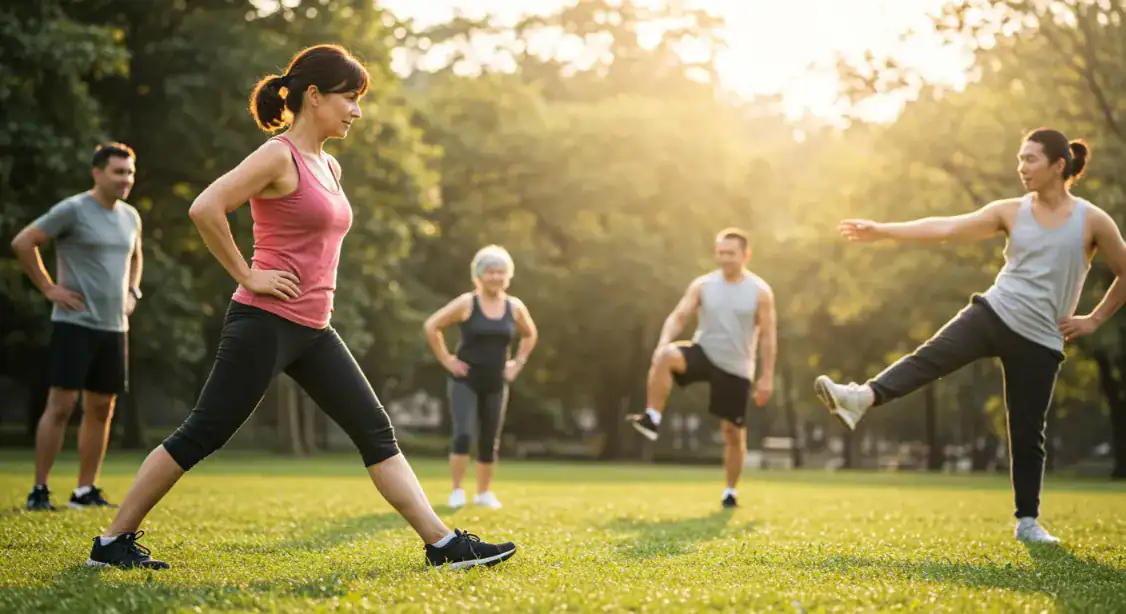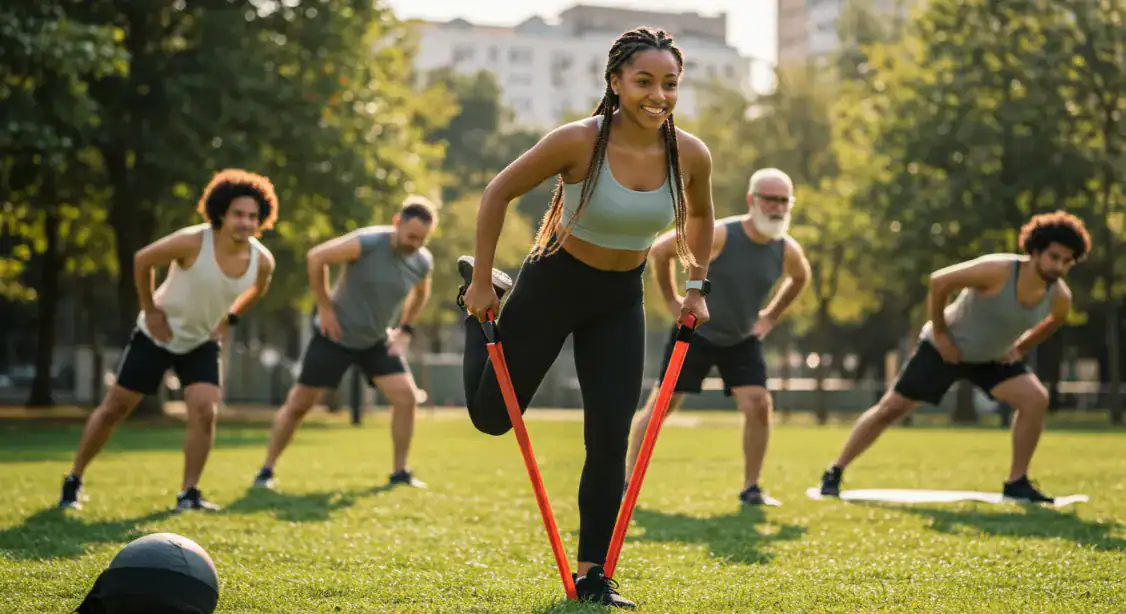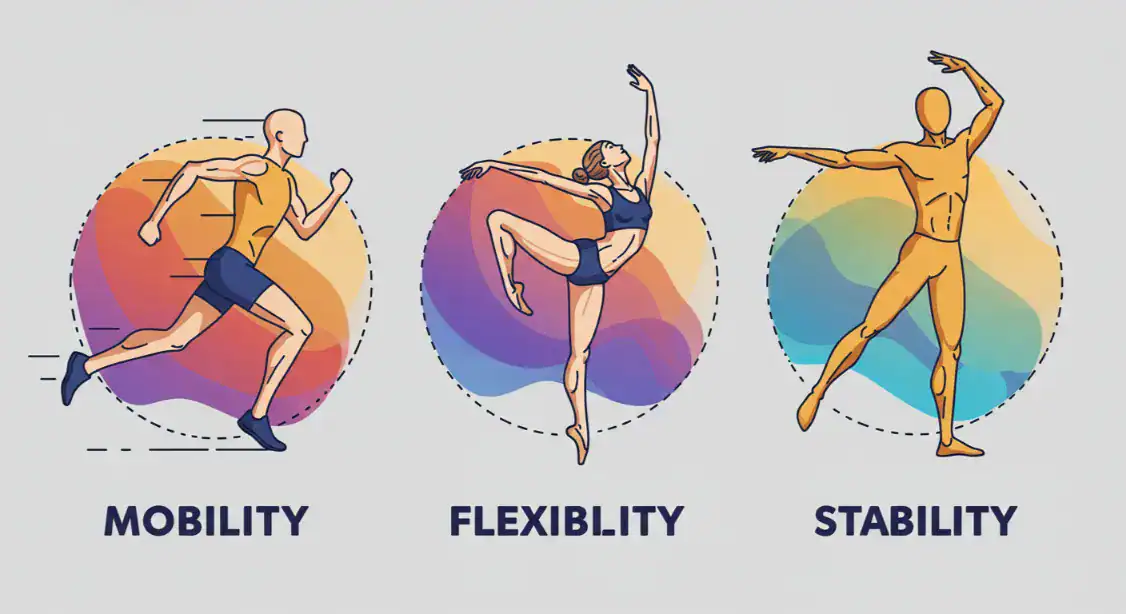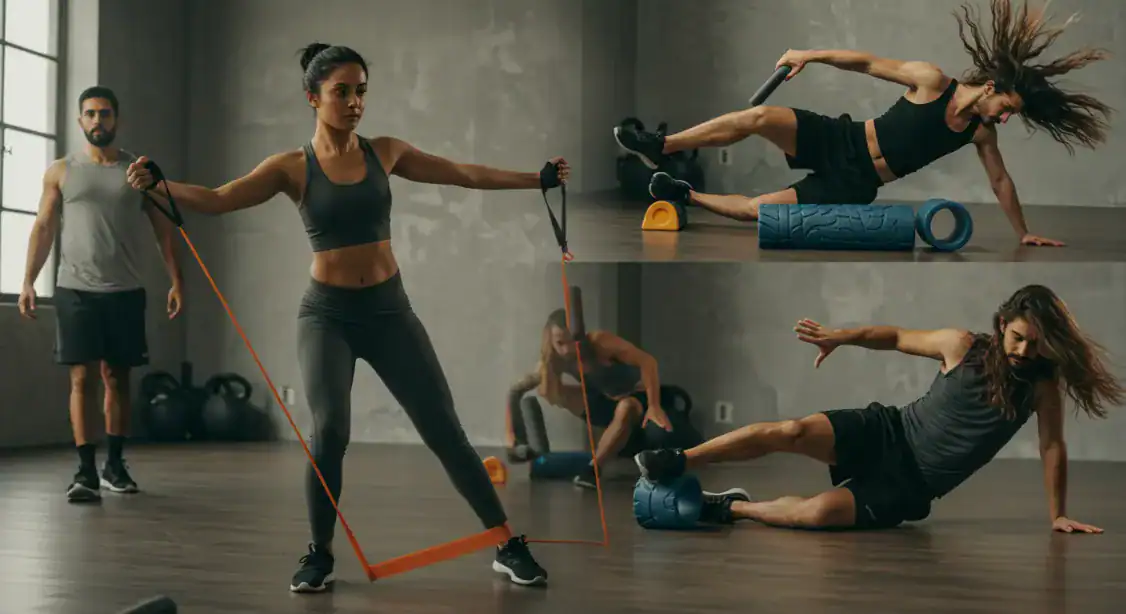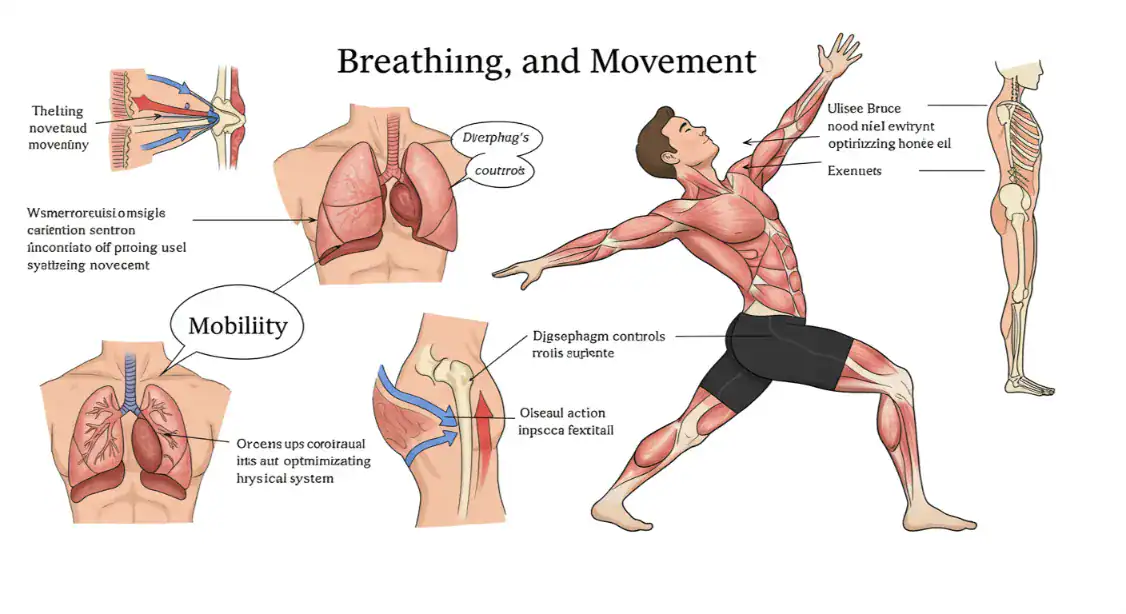Let’s talk straight: Mobility training is all about improving how well your joints move through their full, intended range of motion—but here’s the kicker—doing it with Active control and muscle strength.
Forget just passively stretching; this is about teaching your body to own its movement potential. Think of it as upgrading your body’s operating system for smoother, more efficient functional movements.
Whether you want to achieve your fitness goals, reduce your risk of injury, or simply navigate daily life without feeling like the Tin Man before he got oiled, focusing on mobility training exercises is non-negotiable.
Ever feel that pinch in your shoulder reaching up high? Or that tight, restricted feeling in your hips after sitting? That’s often your body signaling a need for better joint mobility. Ignoring these mobility issues is like trying to run a marathon with your shoes tied together—possible, maybe, but painful, inefficient, and practically begging for trouble. Good mobility isn’t a luxury; it’s fundamental to healthy movement and a higher quality of life.
Key Takeaways
- Mobility Defined: It’s your joint’s ability to actively move through its maximum range of motion with control, distinct from passive flexibility.
- Why It’s Crucial: Reduces injury risk, boosts athletic performance, improves posture improvement, eases muscle tension, enhances daily activities, and supports long-term joint health.
- Mobility vs. Flexibility: Flexibility = passive stretch (how far it can go). Mobility = active, controlled movement (how far you can move it). Both matter, but mobility needs strength.
- Get Started Simply: Incorporate dynamic stretching and specific Mobility Exercises like hip circles, cat-cows, and thoracic rotations into your daily routine.
- Consistency Wins: Aim for short, frequent sessions (10-20 mins, 5+ days/week) rather than occasional marathon efforts. Consistent movement is key.
- Listen Up: Pay attention to your body awareness. Mobility work should feel like a productive challenge, not sharp pain.
Unpacking Mobility: More Than Just Being Bendy
Let’s clear up the confusion between flexibility and mobility right now, because it’s important. Flexibility is passive. Think about lying on your back and using a strap to pull your leg towards your head. Your hamstring is stretching, but are you actively controlling that range? Not really. That’s flexibility.
Mobility, on the other hand, is active. Imagine standing and lifting your knee towards your chest, holding it there using your hip flexor and core strength. Or performing deep squats where you control the descent and ascent through your hips, knees, and ankles without collapsing or needing support. That’s joint mobility in action—it requires muscle strength, coordination, and nervous system engagement. You need Active control through the entire body‘s movement.
Why does this matter? Because life requires active movement! Tossing a ball, picking up groceries, even just walking efficiently—these are all functional movements demanding optimal mobility. Improving your mobility helps refine your movement patterns, making you stronger, more efficient, and less prone to compensation injuries. Explore how this foundational work complements specialized training like CrossFit for teens.
My Personal Experience: I used to think my tight hamstrings were the sole reason my squat depth sucked. I stretched them religiously, but saw little change. Then, I shifted focus to Hip mobility drills—things like controlled leg swings and hip CARs (Controlled Articular Rotations).
It wasn’t just about flexibility; it was about teaching my hip joint to move freely and actively within its socket. Within weeks, not only could I achieve a deeper squat with better form, but that nagging lower back ache started to fade.
It highlighted how interconnected everything is and the power of focusing on active range of motion. For more on squats, check out the benefits of adding barbell squats to your set.
The Real-World Wins: Why Prioritize Mobility Training?
This isn’t just another fitness trend; the effects of mobility training deliver tangible benefits across the board.
Injury Prevention Powerhouse
This is arguably the biggest sell. Better joint mobility means your body can absorb and distribute forces more effectively during physical activity.
When joints can move freely through their intended paths, there’s less stress on surrounding connective tissues and less chance of compensatory movements that lead to strain or pain.
Think of dynamic stretching incorporated into mobility work – it increases blood flow, warms tissues, and prepares the body for load, significantly lowering the risk of injury. Many review authors analyzing research, including studies from the Cochrane Database of Systematic Reviews, consistently point towards the beneficial effects of exercise interventions that include mobility components for various populations.
For targeted injury prevention advice, see how to avoid injuries while working out.
Unleash Your Performance Potential
Want to run faster, lift heavier, or just move more gracefully? Optimal mobility is your foundation. When your joints move well, you can get into better positions to generate force. Think a deeper squat, a more efficient golf swing, or a smoother running stride.
A systematic review and meta-analysis published in 2024 found that mobility training generally helped or maintained sports performance. Improved movement patterns mean less wasted energy and more power directed towards your fitness goals. Considering high-intensity work? See how many calories HIIT burns.
Upgrade Your Daily Life
Mobility isn’t just for athletes; it dramatically impacts your quality of life. Simple things like reaching overhead, getting up from a chair, gardening, or playing with kids become easier and more comfortable. Good joint movement reduces stiffness and can alleviate muscle tension built up from sitting or repetitive tasks.
This is vital for everyone, but especially for community-dwelling older adults, where maintaining mobility is key to independence. Research published in journals like the Journal of Aging and Physical Activity supports mobility interventions for frail older adults. For exercises tailored to this group, explore chair exercises for older adults with limited mobility.
Better Posture and Less Pain
Stuck at a desk? Mobility exercises focusing on the spine (especially the upper back), shoulders, and hips can counteract the slumping effects of modern life, leading to significant posture improvement. This, in turn, can reduce chronic aches and muscle soreness often linked to poor alignment and limited range of motion.
Your Mobility Toolkit: Simple Exercises to Start Today
You don’t need a fancy gym. You just need a little space, a comfortable surface, and consistency. Focus on smooth, controlled movements.
Foundational Mobility Exercises
Integrate these into your warm-ups or as standalone “movement snacks” throughout the day. Aim for 8-10 reps or 30-60 seconds per side where applicable.
- Cat-Cow:
- Starting position: Hands and knees, wrists under shoulders, knees under hips.
- Movement: Inhale, drop your belly button towards the floor, arch your back, look up (Cow). Exhale, round your spine towards the ceiling, tuck your chin (Cat). Focus on moving vertebra by vertebra. Great for spinal joint mobility.
- Thoracic Spine Rotations (Open Books):
- Starting position: Lie on your side, knees bent towards chest, arms straight out in front, palms together.
- Movement: Keeping hips stacked, inhale and lift the top arm, rotating your upper body open towards the floor behind you. Exhale and return to start. Improves upper back rotation.
- Hip CARs (Controlled Articular Rotations):
- Starting position: Stand tall (use support if needed) or start on hands and knees.
- Movement: Keeping your core tight and pelvis stable, slowly draw the biggest possible circle with one knee, moving the hip through its full range of motion (forward, out, back, down). Control is key; avoid momentum. Reverse direction. Targets Hip mobility.
- Ankle CARs:
- Starting position: Sit or stand. Lift one foot slightly.
- Movement: Slowly draw the biggest possible circle with your toes, isolating movement at the ankle joint. Go clockwise and counter-clockwise. Keep your foot flat in the imagination as you circle.
- World’s Greatest Stretch:
- Starting position: High plank position.
- Movement: Step your left foot outside your left hand (keep feet flat or as close as possible). Drop your left elbow towards your instep. Rotate your chest open to the left, reaching your left arm up. Return hand to floor, step back to plank, repeat on the right. Hits multiple joints.
Tools That Can Help (But Aren’t Required)
- Resistance Bands: Add challenge or assistance to drills like leg swings or shoulder work. Find the best resistance bands here.
- Foam Rollers: Help address soft tissue restrictions and muscle tension that can limit joint movement. Explore foam roller options.
- Yoga Blocks: Can provide support to make certain positions more accessible, allowing you to focus on the targeted joint mobility.
- Stick Mobility: Uses specialized sticks to improve range, stability, and body awareness.
Making Mobility Stick: Integrating it Seamlessly
Knowing is half the battle; doing is the other half. Here’s how to make mobility part of your lifestyle choices.
When and How Often?
- Daily Dose: Aim for 10-20 minutes most days of the week (5+). Consistency trumps duration.
- Warm-up Wonder: Use 5-10 minutes of dynamic movements and mobility drills before workouts to prepare your entire body. This is far superior to static stretching pre-exercise for performance and injury risk reduction.
- Cool-down Companion: Gentle mobility work can aid recovery and ease muscle soreness post-workout. Learn more about how to recover from workouts.
- Movement Snack: Stuck at a desk? Take a 2-minute movement snack every hour—do some neck rolls, shoulder shrugs, spinal twists. Even short bursts during your lunch break add up!
- Evening Unwind: Light mobility before bed can release the day’s muscle tension.
Progressing Your Practice
- Increase Range: Gradually work towards moving through a larger range of motion, always maintaining control.
- Add Complexity: Move from simple joint circles to more complex movement patterns involving multiple joints.
- Introduce Holds: Pause for 2-3 seconds at the end range of a controlled movement to build strength and control there.
- Use Tools: Incorporate resistance bands or tools like Stick Mobility for added challenge.
- Consider Guidance: A physical therapist, qualified coach, or a reputable mobility app can provide personalized guidance and ensure proper form, especially if you have limited mobility or past injuries.
Common Pitfalls to Avoid
- Pain vs. Discomfort: Learn the difference. Stretching discomfort is okay; sharp joint pain is not. Back off if you feel pain.
- Rushing: Mobility requires focus and control. Sloppy, fast movements defeat the purpose.
- Ignoring Weakness: Mobility isn’t just stretching; it requires strength at end ranges. Don’t neglect the control aspect.
- Inconsistency: Doing mobility work sporadically won’t yield lasting results. Make it a habit.
- Comparing Yourself: Everyone’s structure and history are different. Focus on your own progress, not the person next to you in hot yoga.
The Bottom Line: Invest in Your Movement Freedom
Mobility training isn’t just another box to check in your fitness routine; it’s a fundamental investment in making your body strong, resilient, and capable for the long haul. It enhances everything from your athletic performance to your ability to enjoy daily activities pain-free.
The beneficial effects are well-documented, from reducing injury risk to improving quality of life, particularly for populations like community-dwelling older adults.
By dedicating just a small amount of time consistently to mobility training exercises and dynamic stretching, focusing on Active control through your range of motion, you unlock a world of better movement.
Start simple, be patient, listen to your body, and embrace the journey towards a more mobile, capable you. Your body will thank you for it—today, tomorrow, and for years to come. Ready to take the next step towards a healthier life? Explore how fitness can become a core part of your identity with how to make fitness a part of your lifestyle.
References
- ACE Fitness: The Surprising Benefits of Performing Daily Mobility Exercises – https://www.acefitness.org/continuing-education/certified/september-2023/8429/the-surprising-benefits-of-performing-daily-mobility-exercises/
- Women’s Health Magazine: Best Mobility Exercises – https://www.womenshealthmag.com/fitness/a40059106/mobility-exercises/
- ISSA Online: Mobility vs. Flexibility: What’s the Difference? – https://www.issaonline.com/blog/post/mobility-vs-flexibility-whats-the-difference
- Livestrong: Beginner Mobility Exercises – https://www.livestrong.com/article/13768917-beginner-mobility-exercises/
- Planet Fitness: What Is Mobility Training? – https://www.planetfitness.com/community/articles/what-is-mobility-training
- PureGym: Flexibility vs Mobility – https://www.puregym.com/blog/flexibility-vs-mobility/
- PubMed Central (Systematic Review): Mobility training in sporting populations: A systematic review – https://pubmed.ncbi.nlm.nih.gov/38433623/
- PubMed Central (Cochrane Review): Mobility training for improving mobility in older adults – https://pubmed.ncbi.nlm.nih.gov/35771806/
- NESTA: Why You Should Start Mobility Training – https://www.nestacertified.com/why-you-should-start-mobility-training/
- EGYM: Smart Flex Mobility Training – https://egym.com/en-gb/workouts/smartflex
As a veteran fitness technology innovator and the founder of GearUpToFit.com, Alex Papaioannou stands at the intersection of health science and artificial intelligence. With over a decade of specialized experience in digital wellness solutions, he’s transforming how people approach their fitness journey through data-driven methodologies.

